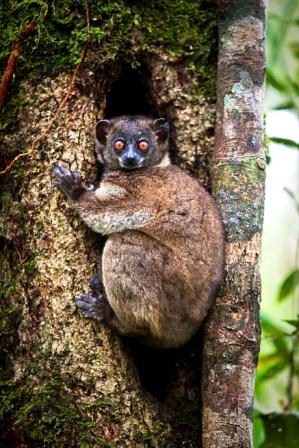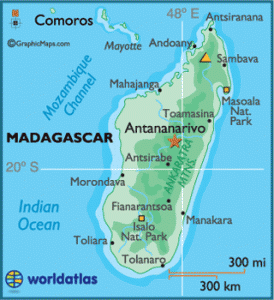Bug-Eyed Over Lemurs!
Travel Far, Think Big: Wild Madagascar
Kasey-Dee Gardner
 Two years ago, on our first date, Dan told me the one place he couldn’t wait to visit was Madagascar. I didn’t know much about Madagascar and honestly doubt I could even point to it on a map. But now, unbelievably, we’re about to head off on a two-week adventure to this island.
Two years ago, on our first date, Dan told me the one place he couldn’t wait to visit was Madagascar. I didn’t know much about Madagascar and honestly doubt I could even point to it on a map. But now, unbelievably, we’re about to head off on a two-week adventure to this island.
Very few people will ever have the chance to discover Madagascar. It’s the world’s fourth largest island that lies just east of Mozambique; it’s an Indian Ocean island that separated from the rest of Africa some 160 million years ago. So, because of its isolation, it’s home to some of the world’s remarkable primates, reptiles, and bizarre planet life that are only naturally found here . It’s hard to get to, yes, but well worth it – especially for nature lovers.
And that’s exactly why we want to check it out.
We’re about to start our 23-hour journey from New York to Madagascar. We’re finalizing the details and finding out that we’re going to need a translator and guide, since neither of us speak French or Malagasy – the two official languages of the country. We’d also better have enough cash on hand, as credit cards are not the norm, and it’s best to load up on Cliff Bars and snacks, since it’s a tricky place for the vegetarian palate. If you want to see wild lemurs and nocturnal chameleons, and experience remaining untouched jungles, travel is going to be rigorous, and accommodations are not always five-star (mosquitoes, geckos, and frogs in the hotel rooms), but adventure is guaranteed.
Madagascar is a country with a limited future. It’s a true posterchild of ecological disaster. It’s unique in its life forms and we wanted to appreciate it while we still have the chance. We can’t see everything in two weeks, so we’re going to spend a few days in Madagascar’s capital city, Antananarivo, followed by a week south discovering the lemurs in the rainforests of Ranomafana, and we’ll wrap up our trip in northern beaches of Mahambo.
 I have no idea what to expect. I’ve read sobering statistics of how Madagascar’s unique forests are under severe threat; I imagine it almost as a barren wasteland. Estimates from Conservation International say that roughly 80 percent of Madagascar has been deforested due to slash and burn practices. I’ve read pollution in the cities is overwhelming, and that entire species are quickly going extinct because of habitat loss, hunting and illegal trade. Will I really get to see a lemur, or are their numbers that dire? The waters are suffering, too, from overfishing and coastal erosion.
I have no idea what to expect. I’ve read sobering statistics of how Madagascar’s unique forests are under severe threat; I imagine it almost as a barren wasteland. Estimates from Conservation International say that roughly 80 percent of Madagascar has been deforested due to slash and burn practices. I’ve read pollution in the cities is overwhelming, and that entire species are quickly going extinct because of habitat loss, hunting and illegal trade. Will I really get to see a lemur, or are their numbers that dire? The waters are suffering, too, from overfishing and coastal erosion.
And that’s exactly why we decided to travel across the world to visit this country — while we still can.
I have to run…we’re about about to leave.
Photos: Dan Plimpton
Related Links:
Conservation International
World Wildlife
Wild Madagascar
Lonely Planet
U.S. State Department info
